Business Environment Assignment :Asda stores Ltd
VerifiedAdded on 2021/01/02
|14
|4168
|110
AI Summary
Contribute Materials
Your contribution can guide someone’s learning journey. Share your
documents today.
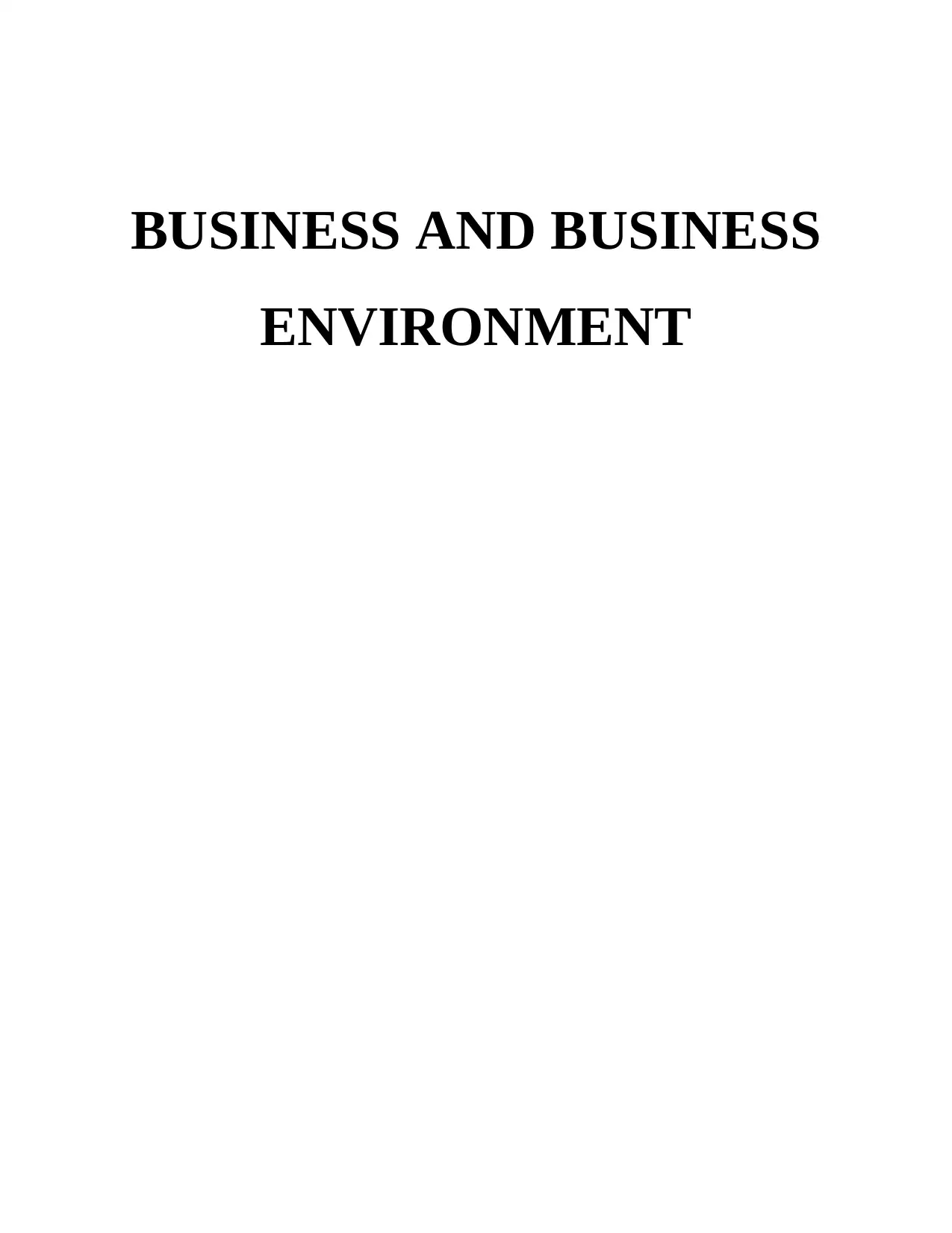
BUSINESS AND BUSINESS
ENVIRONMENT
ENVIRONMENT
Secure Best Marks with AI Grader
Need help grading? Try our AI Grader for instant feedback on your assignments.
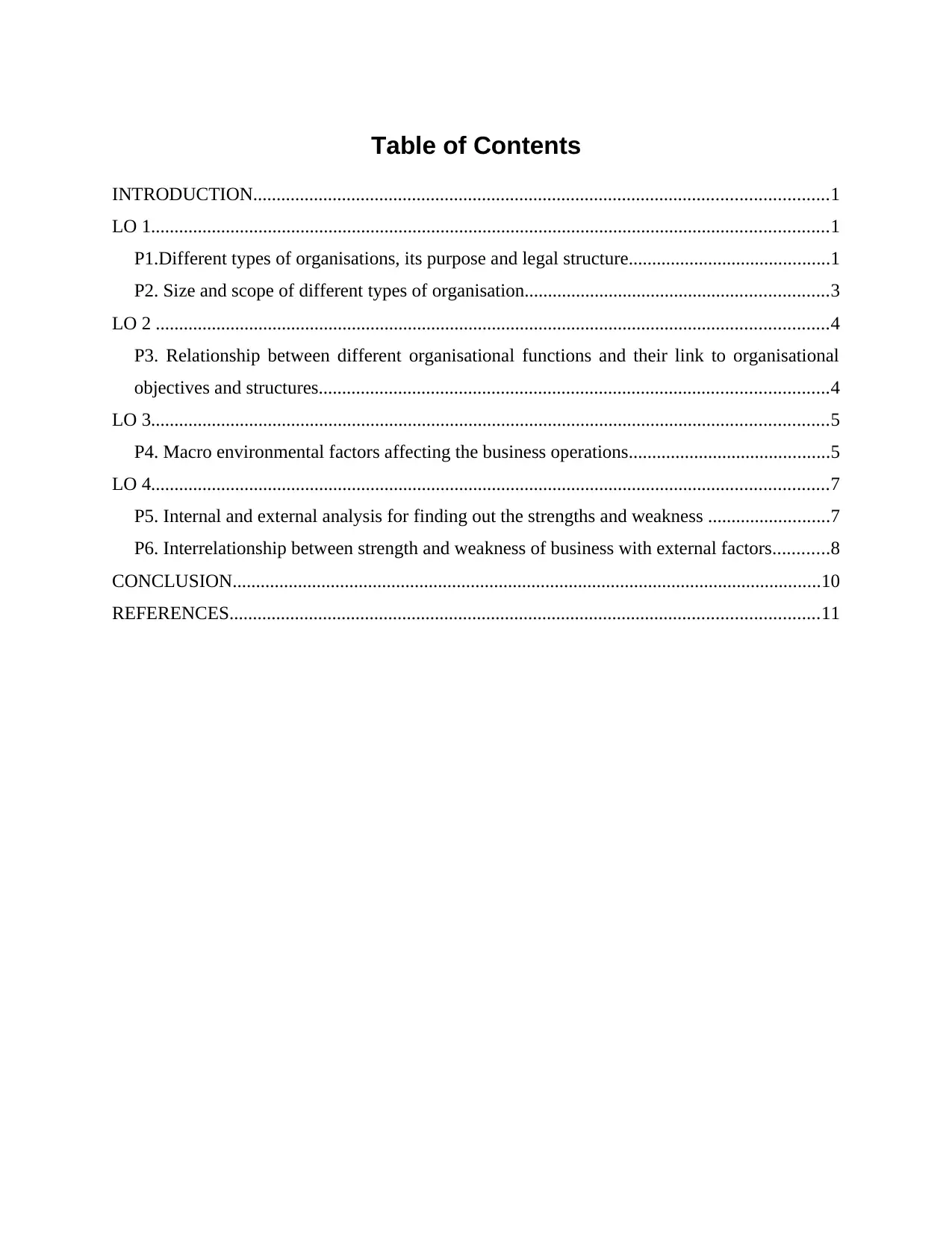
Table of Contents
INTRODUCTION...........................................................................................................................1
LO 1.................................................................................................................................................1
P1.Different types of organisations, its purpose and legal structure...........................................1
P2. Size and scope of different types of organisation.................................................................3
LO 2 ................................................................................................................................................4
P3. Relationship between different organisational functions and their link to organisational
objectives and structures.............................................................................................................4
LO 3.................................................................................................................................................5
P4. Macro environmental factors affecting the business operations...........................................5
LO 4.................................................................................................................................................7
P5. Internal and external analysis for finding out the strengths and weakness ..........................7
P6. Interrelationship between strength and weakness of business with external factors............8
CONCLUSION..............................................................................................................................10
REFERENCES..............................................................................................................................11
INTRODUCTION...........................................................................................................................1
LO 1.................................................................................................................................................1
P1.Different types of organisations, its purpose and legal structure...........................................1
P2. Size and scope of different types of organisation.................................................................3
LO 2 ................................................................................................................................................4
P3. Relationship between different organisational functions and their link to organisational
objectives and structures.............................................................................................................4
LO 3.................................................................................................................................................5
P4. Macro environmental factors affecting the business operations...........................................5
LO 4.................................................................................................................................................7
P5. Internal and external analysis for finding out the strengths and weakness ..........................7
P6. Interrelationship between strength and weakness of business with external factors............8
CONCLUSION..............................................................................................................................10
REFERENCES..............................................................................................................................11
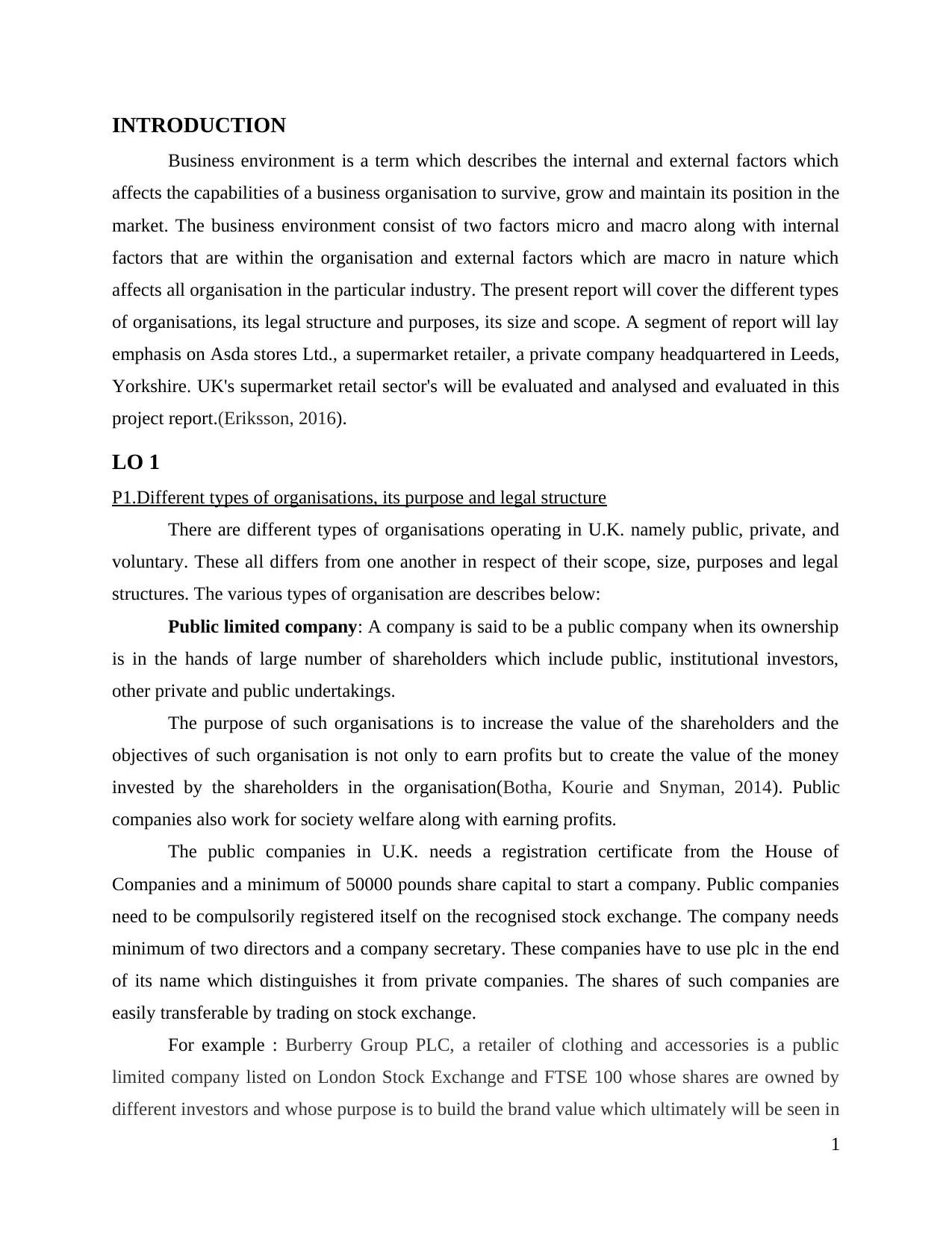
INTRODUCTION
Business environment is a term which describes the internal and external factors which
affects the capabilities of a business organisation to survive, grow and maintain its position in the
market. The business environment consist of two factors micro and macro along with internal
factors that are within the organisation and external factors which are macro in nature which
affects all organisation in the particular industry. The present report will cover the different types
of organisations, its legal structure and purposes, its size and scope. A segment of report will lay
emphasis on Asda stores Ltd., a supermarket retailer, a private company headquartered in Leeds,
Yorkshire. UK's supermarket retail sector's will be evaluated and analysed and evaluated in this
project report.(Eriksson, 2016).
LO 1
P1.Different types of organisations, its purpose and legal structure
There are different types of organisations operating in U.K. namely public, private, and
voluntary. These all differs from one another in respect of their scope, size, purposes and legal
structures. The various types of organisation are describes below:
Public limited company: A company is said to be a public company when its ownership
is in the hands of large number of shareholders which include public, institutional investors,
other private and public undertakings.
The purpose of such organisations is to increase the value of the shareholders and the
objectives of such organisation is not only to earn profits but to create the value of the money
invested by the shareholders in the organisation(Botha, Kourie and Snyman, 2014). Public
companies also work for society welfare along with earning profits.
The public companies in U.K. needs a registration certificate from the House of
Companies and a minimum of 50000 pounds share capital to start a company. Public companies
need to be compulsorily registered itself on the recognised stock exchange. The company needs
minimum of two directors and a company secretary. These companies have to use plc in the end
of its name which distinguishes it from private companies. The shares of such companies are
easily transferable by trading on stock exchange.
For example : Burberry Group PLC, a retailer of clothing and accessories is a public
limited company listed on London Stock Exchange and FTSE 100 whose shares are owned by
different investors and whose purpose is to build the brand value which ultimately will be seen in
1
Business environment is a term which describes the internal and external factors which
affects the capabilities of a business organisation to survive, grow and maintain its position in the
market. The business environment consist of two factors micro and macro along with internal
factors that are within the organisation and external factors which are macro in nature which
affects all organisation in the particular industry. The present report will cover the different types
of organisations, its legal structure and purposes, its size and scope. A segment of report will lay
emphasis on Asda stores Ltd., a supermarket retailer, a private company headquartered in Leeds,
Yorkshire. UK's supermarket retail sector's will be evaluated and analysed and evaluated in this
project report.(Eriksson, 2016).
LO 1
P1.Different types of organisations, its purpose and legal structure
There are different types of organisations operating in U.K. namely public, private, and
voluntary. These all differs from one another in respect of their scope, size, purposes and legal
structures. The various types of organisation are describes below:
Public limited company: A company is said to be a public company when its ownership
is in the hands of large number of shareholders which include public, institutional investors,
other private and public undertakings.
The purpose of such organisations is to increase the value of the shareholders and the
objectives of such organisation is not only to earn profits but to create the value of the money
invested by the shareholders in the organisation(Botha, Kourie and Snyman, 2014). Public
companies also work for society welfare along with earning profits.
The public companies in U.K. needs a registration certificate from the House of
Companies and a minimum of 50000 pounds share capital to start a company. Public companies
need to be compulsorily registered itself on the recognised stock exchange. The company needs
minimum of two directors and a company secretary. These companies have to use plc in the end
of its name which distinguishes it from private companies. The shares of such companies are
easily transferable by trading on stock exchange.
For example : Burberry Group PLC, a retailer of clothing and accessories is a public
limited company listed on London Stock Exchange and FTSE 100 whose shares are owned by
different investors and whose purpose is to build the brand value which ultimately will be seen in
1
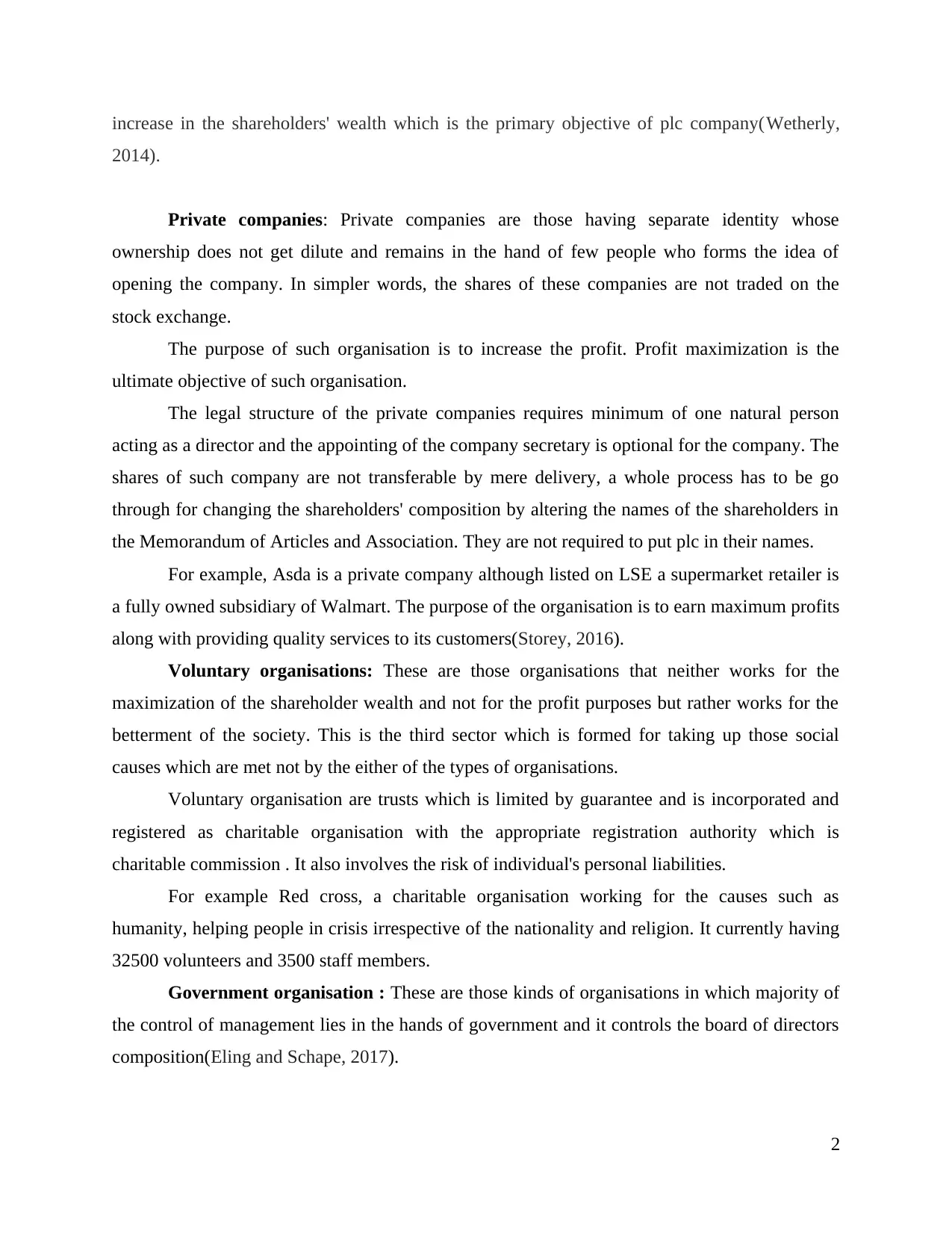
increase in the shareholders' wealth which is the primary objective of plc company(Wetherly,
2014).
Private companies: Private companies are those having separate identity whose
ownership does not get dilute and remains in the hand of few people who forms the idea of
opening the company. In simpler words, the shares of these companies are not traded on the
stock exchange.
The purpose of such organisation is to increase the profit. Profit maximization is the
ultimate objective of such organisation.
The legal structure of the private companies requires minimum of one natural person
acting as a director and the appointing of the company secretary is optional for the company. The
shares of such company are not transferable by mere delivery, a whole process has to be go
through for changing the shareholders' composition by altering the names of the shareholders in
the Memorandum of Articles and Association. They are not required to put plc in their names.
For example, Asda is a private company although listed on LSE a supermarket retailer is
a fully owned subsidiary of Walmart. The purpose of the organisation is to earn maximum profits
along with providing quality services to its customers(Storey, 2016).
Voluntary organisations: These are those organisations that neither works for the
maximization of the shareholder wealth and not for the profit purposes but rather works for the
betterment of the society. This is the third sector which is formed for taking up those social
causes which are met not by the either of the types of organisations.
Voluntary organisation are trusts which is limited by guarantee and is incorporated and
registered as charitable organisation with the appropriate registration authority which is
charitable commission . It also involves the risk of individual's personal liabilities.
For example Red cross, a charitable organisation working for the causes such as
humanity, helping people in crisis irrespective of the nationality and religion. It currently having
32500 volunteers and 3500 staff members.
Government organisation : These are those kinds of organisations in which majority of
the control of management lies in the hands of government and it controls the board of directors
composition(Eling and Schape, 2017).
2
2014).
Private companies: Private companies are those having separate identity whose
ownership does not get dilute and remains in the hand of few people who forms the idea of
opening the company. In simpler words, the shares of these companies are not traded on the
stock exchange.
The purpose of such organisation is to increase the profit. Profit maximization is the
ultimate objective of such organisation.
The legal structure of the private companies requires minimum of one natural person
acting as a director and the appointing of the company secretary is optional for the company. The
shares of such company are not transferable by mere delivery, a whole process has to be go
through for changing the shareholders' composition by altering the names of the shareholders in
the Memorandum of Articles and Association. They are not required to put plc in their names.
For example, Asda is a private company although listed on LSE a supermarket retailer is
a fully owned subsidiary of Walmart. The purpose of the organisation is to earn maximum profits
along with providing quality services to its customers(Storey, 2016).
Voluntary organisations: These are those organisations that neither works for the
maximization of the shareholder wealth and not for the profit purposes but rather works for the
betterment of the society. This is the third sector which is formed for taking up those social
causes which are met not by the either of the types of organisations.
Voluntary organisation are trusts which is limited by guarantee and is incorporated and
registered as charitable organisation with the appropriate registration authority which is
charitable commission . It also involves the risk of individual's personal liabilities.
For example Red cross, a charitable organisation working for the causes such as
humanity, helping people in crisis irrespective of the nationality and religion. It currently having
32500 volunteers and 3500 staff members.
Government organisation : These are those kinds of organisations in which majority of
the control of management lies in the hands of government and it controls the board of directors
composition(Eling and Schape, 2017).
2
Secure Best Marks with AI Grader
Need help grading? Try our AI Grader for instant feedback on your assignments.
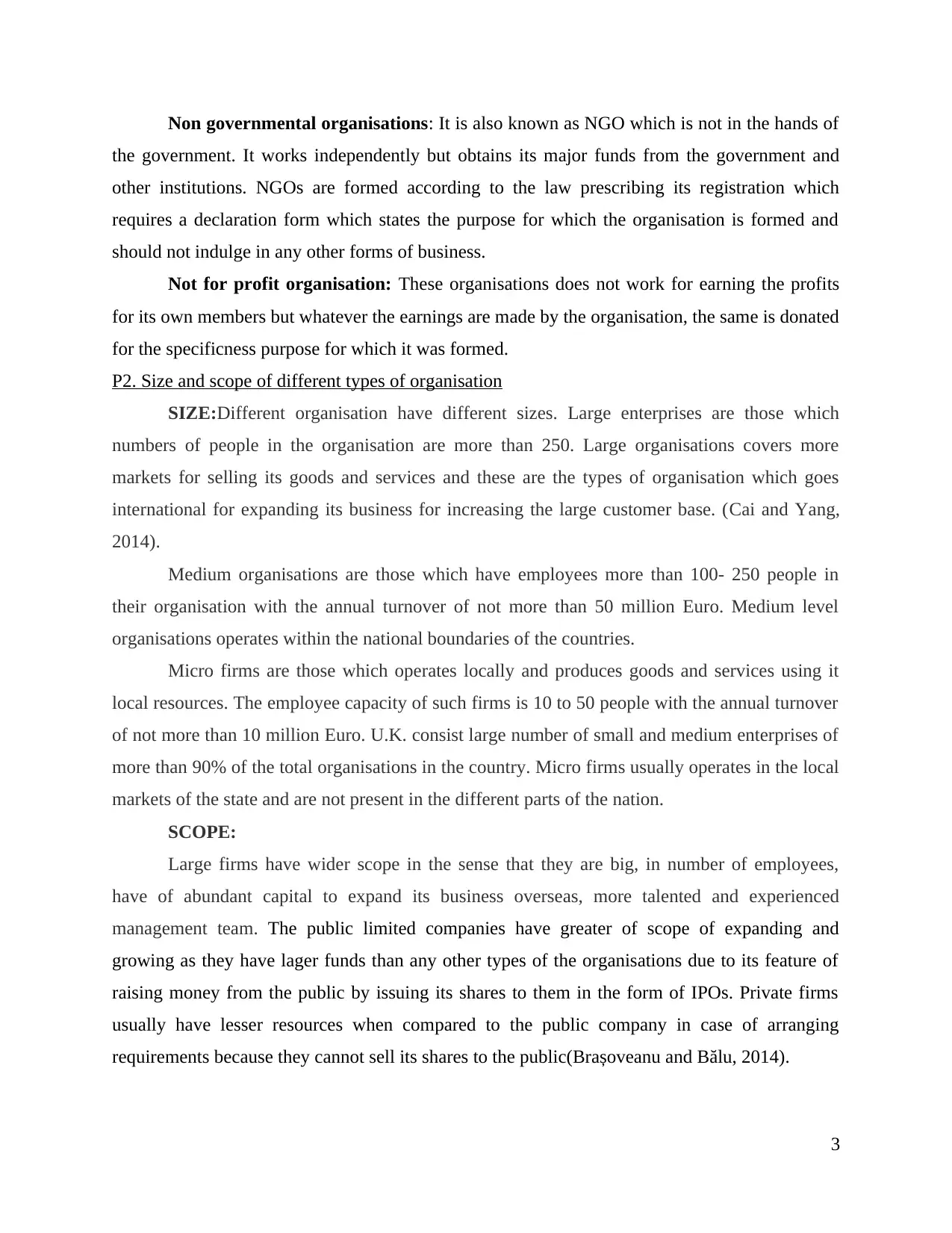
Non governmental organisations: It is also known as NGO which is not in the hands of
the government. It works independently but obtains its major funds from the government and
other institutions. NGOs are formed according to the law prescribing its registration which
requires a declaration form which states the purpose for which the organisation is formed and
should not indulge in any other forms of business.
Not for profit organisation: These organisations does not work for earning the profits
for its own members but whatever the earnings are made by the organisation, the same is donated
for the specificness purpose for which it was formed.
P2. Size and scope of different types of organisation
SIZE:Different organisation have different sizes. Large enterprises are those which
numbers of people in the organisation are more than 250. Large organisations covers more
markets for selling its goods and services and these are the types of organisation which goes
international for expanding its business for increasing the large customer base. (Cai and Yang,
2014).
Medium organisations are those which have employees more than 100- 250 people in
their organisation with the annual turnover of not more than 50 million Euro. Medium level
organisations operates within the national boundaries of the countries.
Micro firms are those which operates locally and produces goods and services using it
local resources. The employee capacity of such firms is 10 to 50 people with the annual turnover
of not more than 10 million Euro. U.K. consist large number of small and medium enterprises of
more than 90% of the total organisations in the country. Micro firms usually operates in the local
markets of the state and are not present in the different parts of the nation.
SCOPE:
Large firms have wider scope in the sense that they are big, in number of employees,
have of abundant capital to expand its business overseas, more talented and experienced
management team. The public limited companies have greater of scope of expanding and
growing as they have lager funds than any other types of the organisations due to its feature of
raising money from the public by issuing its shares to them in the form of IPOs. Private firms
usually have lesser resources when compared to the public company in case of arranging
requirements because they cannot sell its shares to the public(Brașoveanu and Bălu, 2014).
3
the government. It works independently but obtains its major funds from the government and
other institutions. NGOs are formed according to the law prescribing its registration which
requires a declaration form which states the purpose for which the organisation is formed and
should not indulge in any other forms of business.
Not for profit organisation: These organisations does not work for earning the profits
for its own members but whatever the earnings are made by the organisation, the same is donated
for the specificness purpose for which it was formed.
P2. Size and scope of different types of organisation
SIZE:Different organisation have different sizes. Large enterprises are those which
numbers of people in the organisation are more than 250. Large organisations covers more
markets for selling its goods and services and these are the types of organisation which goes
international for expanding its business for increasing the large customer base. (Cai and Yang,
2014).
Medium organisations are those which have employees more than 100- 250 people in
their organisation with the annual turnover of not more than 50 million Euro. Medium level
organisations operates within the national boundaries of the countries.
Micro firms are those which operates locally and produces goods and services using it
local resources. The employee capacity of such firms is 10 to 50 people with the annual turnover
of not more than 10 million Euro. U.K. consist large number of small and medium enterprises of
more than 90% of the total organisations in the country. Micro firms usually operates in the local
markets of the state and are not present in the different parts of the nation.
SCOPE:
Large firms have wider scope in the sense that they are big, in number of employees,
have of abundant capital to expand its business overseas, more talented and experienced
management team. The public limited companies have greater of scope of expanding and
growing as they have lager funds than any other types of the organisations due to its feature of
raising money from the public by issuing its shares to them in the form of IPOs. Private firms
usually have lesser resources when compared to the public company in case of arranging
requirements because they cannot sell its shares to the public(Brașoveanu and Bălu, 2014).
3
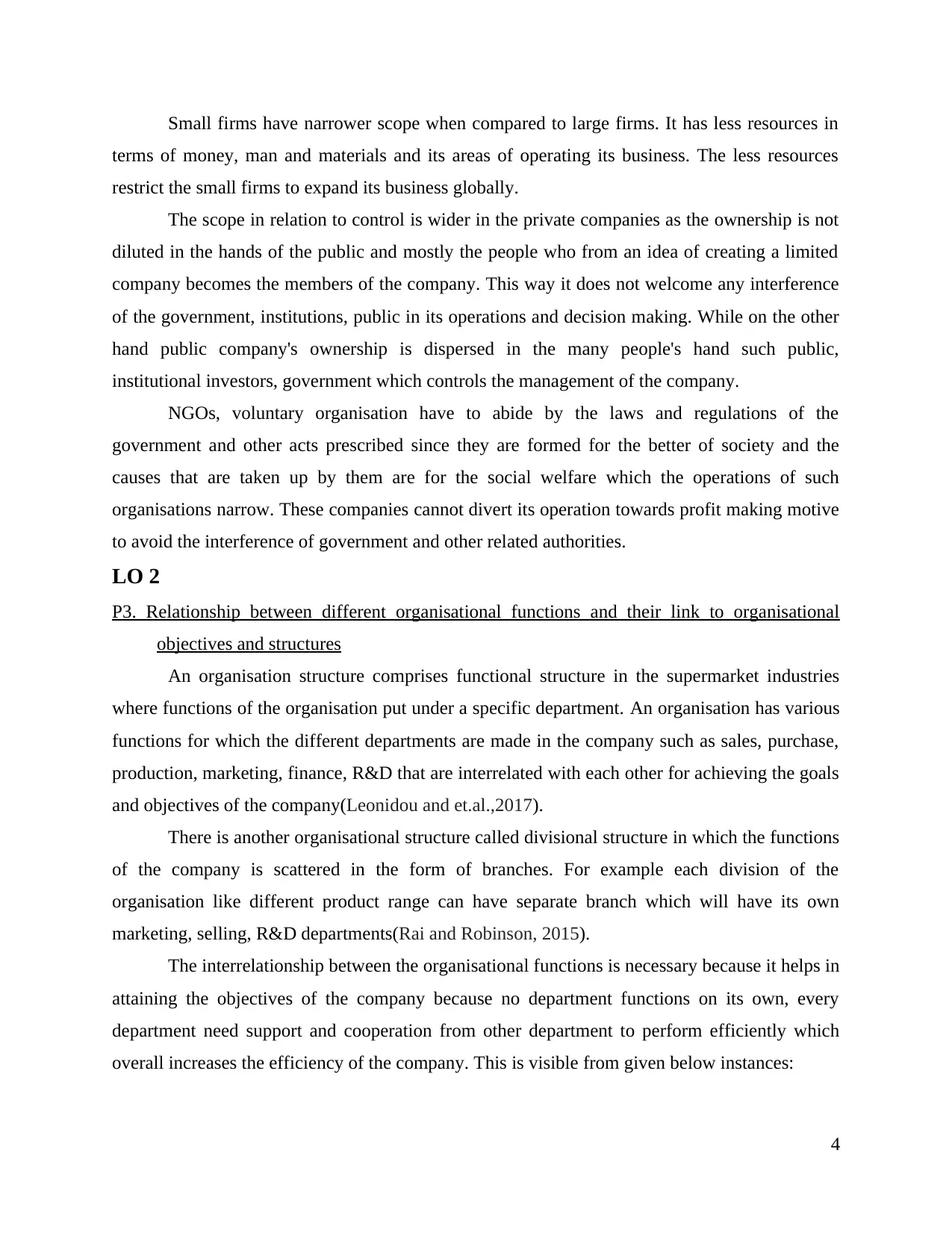
Small firms have narrower scope when compared to large firms. It has less resources in
terms of money, man and materials and its areas of operating its business. The less resources
restrict the small firms to expand its business globally.
The scope in relation to control is wider in the private companies as the ownership is not
diluted in the hands of the public and mostly the people who from an idea of creating a limited
company becomes the members of the company. This way it does not welcome any interference
of the government, institutions, public in its operations and decision making. While on the other
hand public company's ownership is dispersed in the many people's hand such public,
institutional investors, government which controls the management of the company.
NGOs, voluntary organisation have to abide by the laws and regulations of the
government and other acts prescribed since they are formed for the better of society and the
causes that are taken up by them are for the social welfare which the operations of such
organisations narrow. These companies cannot divert its operation towards profit making motive
to avoid the interference of government and other related authorities.
LO 2
P3. Relationship between different organisational functions and their link to organisational
objectives and structures
An organisation structure comprises functional structure in the supermarket industries
where functions of the organisation put under a specific department. An organisation has various
functions for which the different departments are made in the company such as sales, purchase,
production, marketing, finance, R&D that are interrelated with each other for achieving the goals
and objectives of the company(Leonidou and et.al.,2017).
There is another organisational structure called divisional structure in which the functions
of the company is scattered in the form of branches. For example each division of the
organisation like different product range can have separate branch which will have its own
marketing, selling, R&D departments(Rai and Robinson, 2015).
The interrelationship between the organisational functions is necessary because it helps in
attaining the objectives of the company because no department functions on its own, every
department need support and cooperation from other department to perform efficiently which
overall increases the efficiency of the company. This is visible from given below instances:
4
terms of money, man and materials and its areas of operating its business. The less resources
restrict the small firms to expand its business globally.
The scope in relation to control is wider in the private companies as the ownership is not
diluted in the hands of the public and mostly the people who from an idea of creating a limited
company becomes the members of the company. This way it does not welcome any interference
of the government, institutions, public in its operations and decision making. While on the other
hand public company's ownership is dispersed in the many people's hand such public,
institutional investors, government which controls the management of the company.
NGOs, voluntary organisation have to abide by the laws and regulations of the
government and other acts prescribed since they are formed for the better of society and the
causes that are taken up by them are for the social welfare which the operations of such
organisations narrow. These companies cannot divert its operation towards profit making motive
to avoid the interference of government and other related authorities.
LO 2
P3. Relationship between different organisational functions and their link to organisational
objectives and structures
An organisation structure comprises functional structure in the supermarket industries
where functions of the organisation put under a specific department. An organisation has various
functions for which the different departments are made in the company such as sales, purchase,
production, marketing, finance, R&D that are interrelated with each other for achieving the goals
and objectives of the company(Leonidou and et.al.,2017).
There is another organisational structure called divisional structure in which the functions
of the company is scattered in the form of branches. For example each division of the
organisation like different product range can have separate branch which will have its own
marketing, selling, R&D departments(Rai and Robinson, 2015).
The interrelationship between the organisational functions is necessary because it helps in
attaining the objectives of the company because no department functions on its own, every
department need support and cooperation from other department to perform efficiently which
overall increases the efficiency of the company. This is visible from given below instances:
4
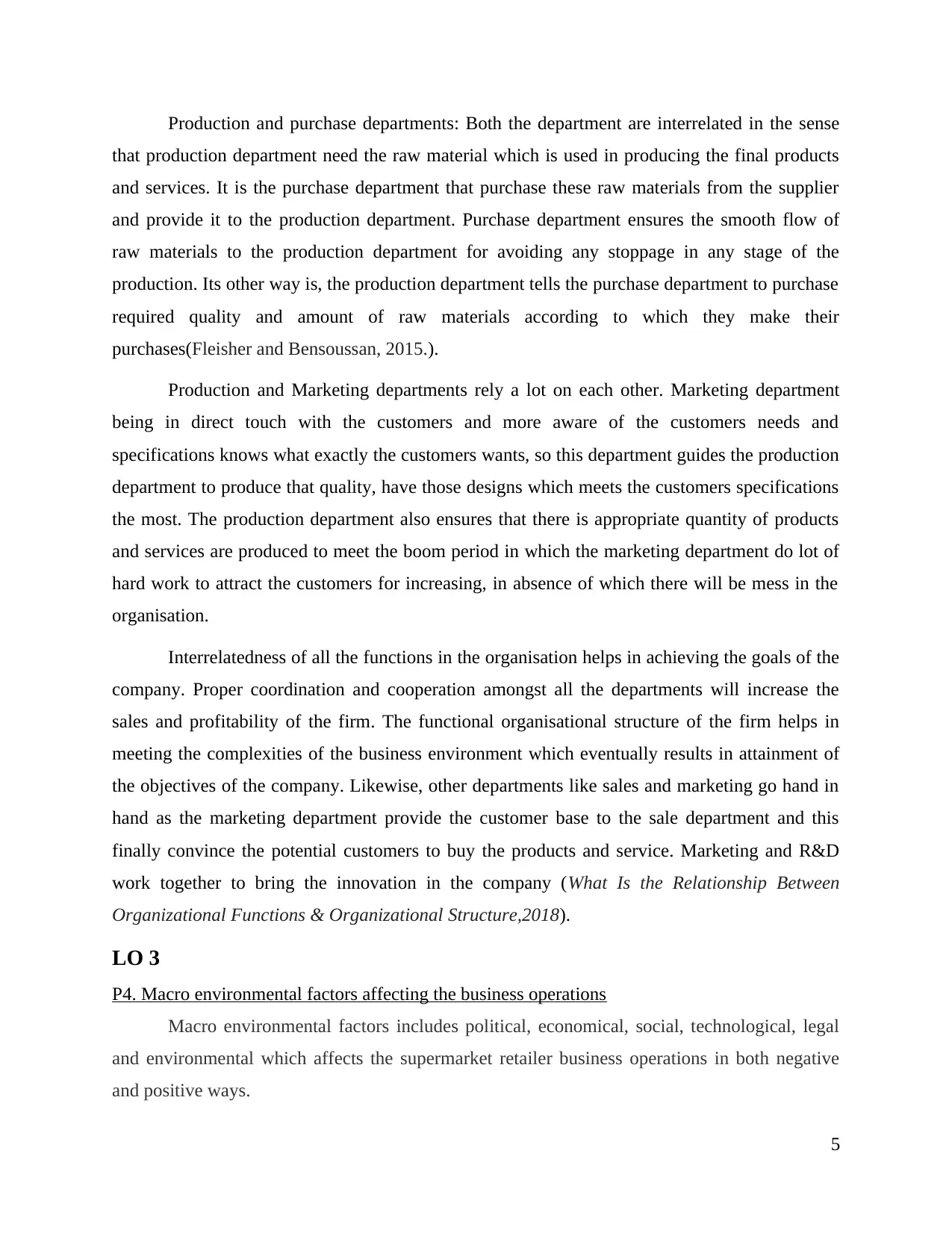
Production and purchase departments: Both the department are interrelated in the sense
that production department need the raw material which is used in producing the final products
and services. It is the purchase department that purchase these raw materials from the supplier
and provide it to the production department. Purchase department ensures the smooth flow of
raw materials to the production department for avoiding any stoppage in any stage of the
production. Its other way is, the production department tells the purchase department to purchase
required quality and amount of raw materials according to which they make their
purchases(Fleisher and Bensoussan, 2015.).
Production and Marketing departments rely a lot on each other. Marketing department
being in direct touch with the customers and more aware of the customers needs and
specifications knows what exactly the customers wants, so this department guides the production
department to produce that quality, have those designs which meets the customers specifications
the most. The production department also ensures that there is appropriate quantity of products
and services are produced to meet the boom period in which the marketing department do lot of
hard work to attract the customers for increasing, in absence of which there will be mess in the
organisation.
Interrelatedness of all the functions in the organisation helps in achieving the goals of the
company. Proper coordination and cooperation amongst all the departments will increase the
sales and profitability of the firm. The functional organisational structure of the firm helps in
meeting the complexities of the business environment which eventually results in attainment of
the objectives of the company. Likewise, other departments like sales and marketing go hand in
hand as the marketing department provide the customer base to the sale department and this
finally convince the potential customers to buy the products and service. Marketing and R&D
work together to bring the innovation in the company (What Is the Relationship Between
Organizational Functions & Organizational Structure,2018).
LO 3
P4. Macro environmental factors affecting the business operations
Macro environmental factors includes political, economical, social, technological, legal
and environmental which affects the supermarket retailer business operations in both negative
and positive ways.
5
that production department need the raw material which is used in producing the final products
and services. It is the purchase department that purchase these raw materials from the supplier
and provide it to the production department. Purchase department ensures the smooth flow of
raw materials to the production department for avoiding any stoppage in any stage of the
production. Its other way is, the production department tells the purchase department to purchase
required quality and amount of raw materials according to which they make their
purchases(Fleisher and Bensoussan, 2015.).
Production and Marketing departments rely a lot on each other. Marketing department
being in direct touch with the customers and more aware of the customers needs and
specifications knows what exactly the customers wants, so this department guides the production
department to produce that quality, have those designs which meets the customers specifications
the most. The production department also ensures that there is appropriate quantity of products
and services are produced to meet the boom period in which the marketing department do lot of
hard work to attract the customers for increasing, in absence of which there will be mess in the
organisation.
Interrelatedness of all the functions in the organisation helps in achieving the goals of the
company. Proper coordination and cooperation amongst all the departments will increase the
sales and profitability of the firm. The functional organisational structure of the firm helps in
meeting the complexities of the business environment which eventually results in attainment of
the objectives of the company. Likewise, other departments like sales and marketing go hand in
hand as the marketing department provide the customer base to the sale department and this
finally convince the potential customers to buy the products and service. Marketing and R&D
work together to bring the innovation in the company (What Is the Relationship Between
Organizational Functions & Organizational Structure,2018).
LO 3
P4. Macro environmental factors affecting the business operations
Macro environmental factors includes political, economical, social, technological, legal
and environmental which affects the supermarket retailer business operations in both negative
and positive ways.
5
Paraphrase This Document
Need a fresh take? Get an instant paraphrase of this document with our AI Paraphraser
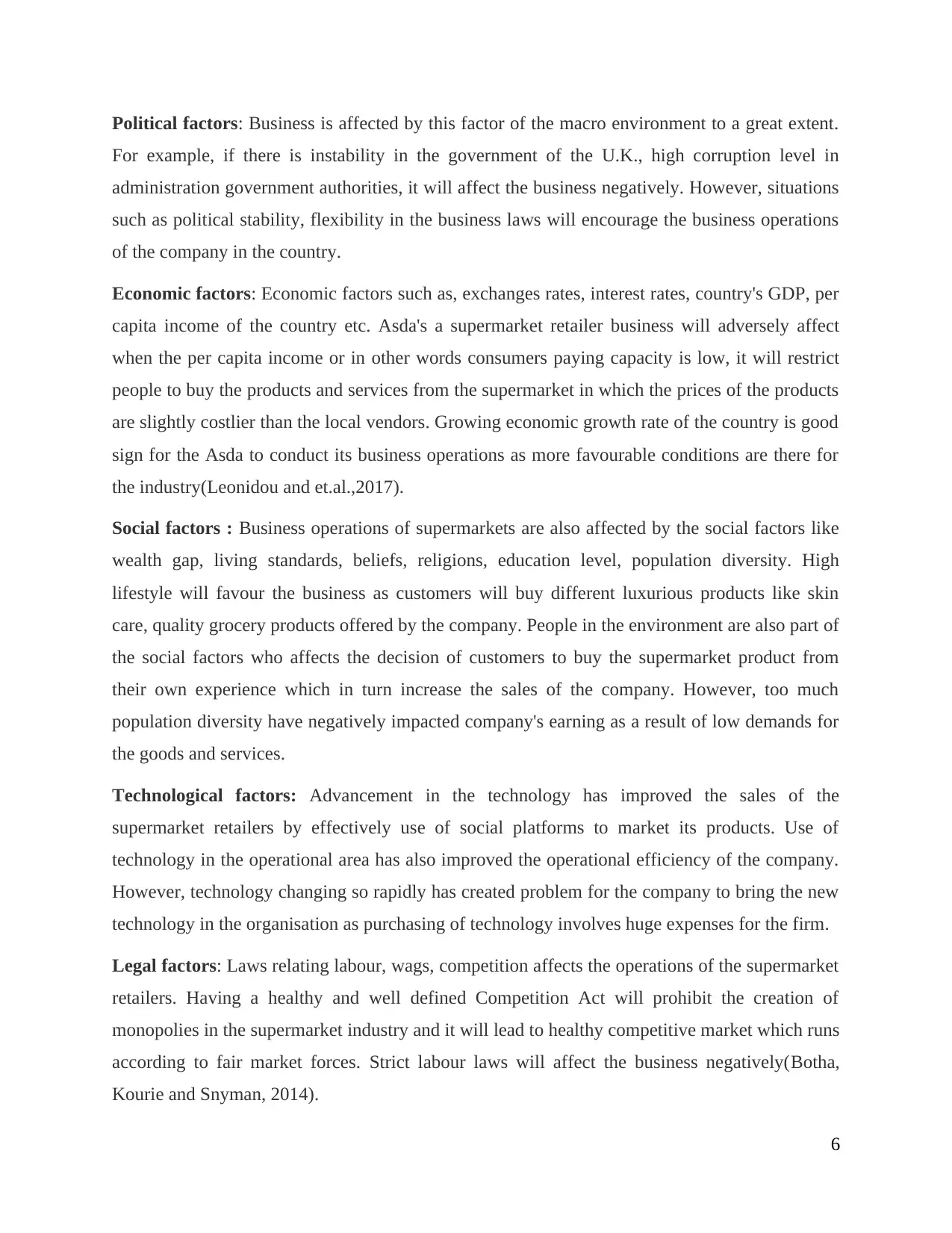
Political factors: Business is affected by this factor of the macro environment to a great extent.
For example, if there is instability in the government of the U.K., high corruption level in
administration government authorities, it will affect the business negatively. However, situations
such as political stability, flexibility in the business laws will encourage the business operations
of the company in the country.
Economic factors: Economic factors such as, exchanges rates, interest rates, country's GDP, per
capita income of the country etc. Asda's a supermarket retailer business will adversely affect
when the per capita income or in other words consumers paying capacity is low, it will restrict
people to buy the products and services from the supermarket in which the prices of the products
are slightly costlier than the local vendors. Growing economic growth rate of the country is good
sign for the Asda to conduct its business operations as more favourable conditions are there for
the industry(Leonidou and et.al.,2017).
Social factors : Business operations of supermarkets are also affected by the social factors like
wealth gap, living standards, beliefs, religions, education level, population diversity. High
lifestyle will favour the business as customers will buy different luxurious products like skin
care, quality grocery products offered by the company. People in the environment are also part of
the social factors who affects the decision of customers to buy the supermarket product from
their own experience which in turn increase the sales of the company. However, too much
population diversity have negatively impacted company's earning as a result of low demands for
the goods and services.
Technological factors: Advancement in the technology has improved the sales of the
supermarket retailers by effectively use of social platforms to market its products. Use of
technology in the operational area has also improved the operational efficiency of the company.
However, technology changing so rapidly has created problem for the company to bring the new
technology in the organisation as purchasing of technology involves huge expenses for the firm.
Legal factors: Laws relating labour, wags, competition affects the operations of the supermarket
retailers. Having a healthy and well defined Competition Act will prohibit the creation of
monopolies in the supermarket industry and it will lead to healthy competitive market which runs
according to fair market forces. Strict labour laws will affect the business negatively(Botha,
Kourie and Snyman, 2014).
6
For example, if there is instability in the government of the U.K., high corruption level in
administration government authorities, it will affect the business negatively. However, situations
such as political stability, flexibility in the business laws will encourage the business operations
of the company in the country.
Economic factors: Economic factors such as, exchanges rates, interest rates, country's GDP, per
capita income of the country etc. Asda's a supermarket retailer business will adversely affect
when the per capita income or in other words consumers paying capacity is low, it will restrict
people to buy the products and services from the supermarket in which the prices of the products
are slightly costlier than the local vendors. Growing economic growth rate of the country is good
sign for the Asda to conduct its business operations as more favourable conditions are there for
the industry(Leonidou and et.al.,2017).
Social factors : Business operations of supermarkets are also affected by the social factors like
wealth gap, living standards, beliefs, religions, education level, population diversity. High
lifestyle will favour the business as customers will buy different luxurious products like skin
care, quality grocery products offered by the company. People in the environment are also part of
the social factors who affects the decision of customers to buy the supermarket product from
their own experience which in turn increase the sales of the company. However, too much
population diversity have negatively impacted company's earning as a result of low demands for
the goods and services.
Technological factors: Advancement in the technology has improved the sales of the
supermarket retailers by effectively use of social platforms to market its products. Use of
technology in the operational area has also improved the operational efficiency of the company.
However, technology changing so rapidly has created problem for the company to bring the new
technology in the organisation as purchasing of technology involves huge expenses for the firm.
Legal factors: Laws relating labour, wags, competition affects the operations of the supermarket
retailers. Having a healthy and well defined Competition Act will prohibit the creation of
monopolies in the supermarket industry and it will lead to healthy competitive market which runs
according to fair market forces. Strict labour laws will affect the business negatively(Botha,
Kourie and Snyman, 2014).
6
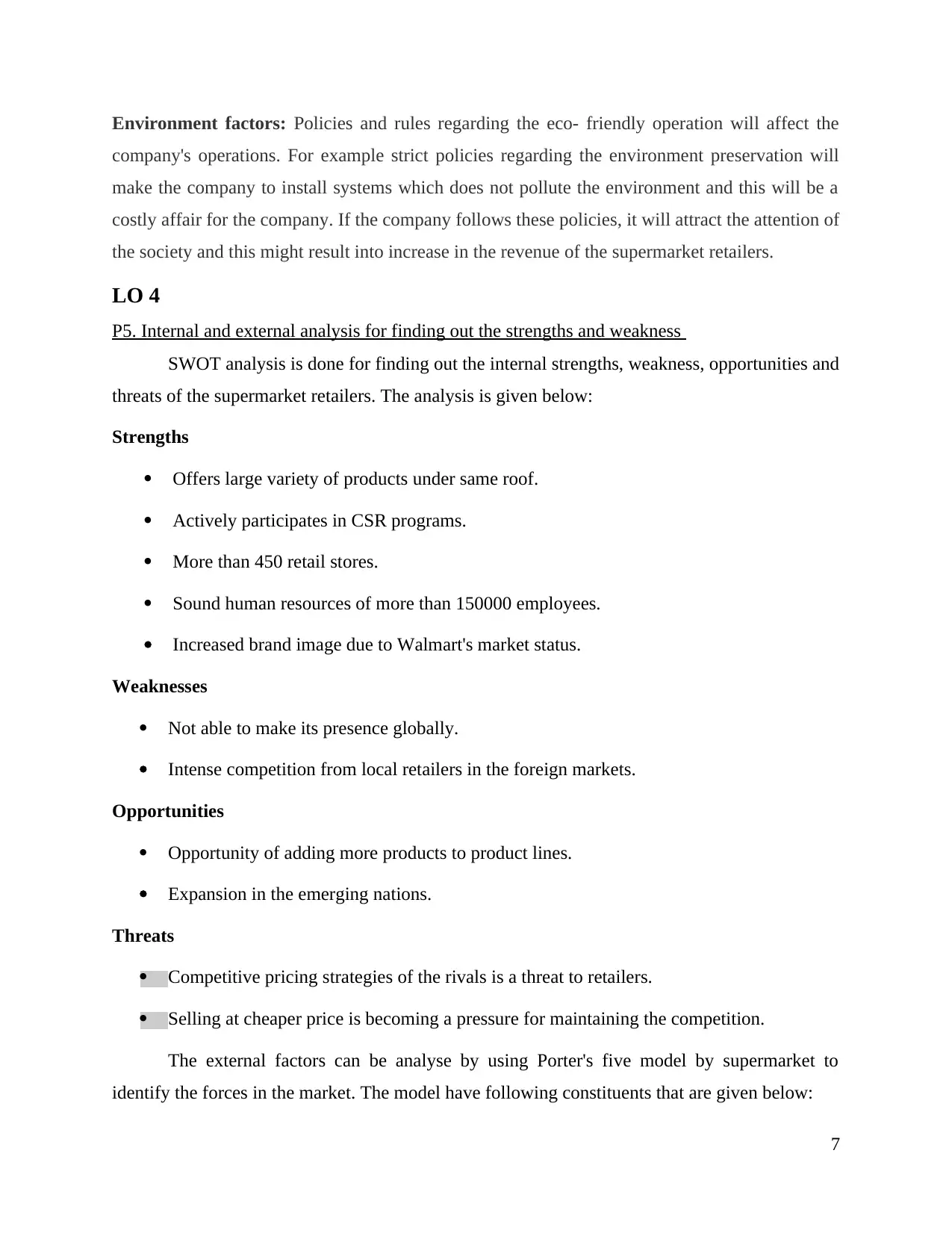
Environment factors: Policies and rules regarding the eco- friendly operation will affect the
company's operations. For example strict policies regarding the environment preservation will
make the company to install systems which does not pollute the environment and this will be a
costly affair for the company. If the company follows these policies, it will attract the attention of
the society and this might result into increase in the revenue of the supermarket retailers.
LO 4
P5. Internal and external analysis for finding out the strengths and weakness
SWOT analysis is done for finding out the internal strengths, weakness, opportunities and
threats of the supermarket retailers. The analysis is given below:
Strengths
Offers large variety of products under same roof.
Actively participates in CSR programs.
More than 450 retail stores.
Sound human resources of more than 150000 employees.
Increased brand image due to Walmart's market status.
Weaknesses
Not able to make its presence globally.
Intense competition from local retailers in the foreign markets.
Opportunities
Opportunity of adding more products to product lines.
Expansion in the emerging nations.
Threats
Competitive pricing strategies of the rivals is a threat to retailers.
Selling at cheaper price is becoming a pressure for maintaining the competition.
The external factors can be analyse by using Porter's five model by supermarket to
identify the forces in the market. The model have following constituents that are given below:
7
company's operations. For example strict policies regarding the environment preservation will
make the company to install systems which does not pollute the environment and this will be a
costly affair for the company. If the company follows these policies, it will attract the attention of
the society and this might result into increase in the revenue of the supermarket retailers.
LO 4
P5. Internal and external analysis for finding out the strengths and weakness
SWOT analysis is done for finding out the internal strengths, weakness, opportunities and
threats of the supermarket retailers. The analysis is given below:
Strengths
Offers large variety of products under same roof.
Actively participates in CSR programs.
More than 450 retail stores.
Sound human resources of more than 150000 employees.
Increased brand image due to Walmart's market status.
Weaknesses
Not able to make its presence globally.
Intense competition from local retailers in the foreign markets.
Opportunities
Opportunity of adding more products to product lines.
Expansion in the emerging nations.
Threats
Competitive pricing strategies of the rivals is a threat to retailers.
Selling at cheaper price is becoming a pressure for maintaining the competition.
The external factors can be analyse by using Porter's five model by supermarket to
identify the forces in the market. The model have following constituents that are given below:
7
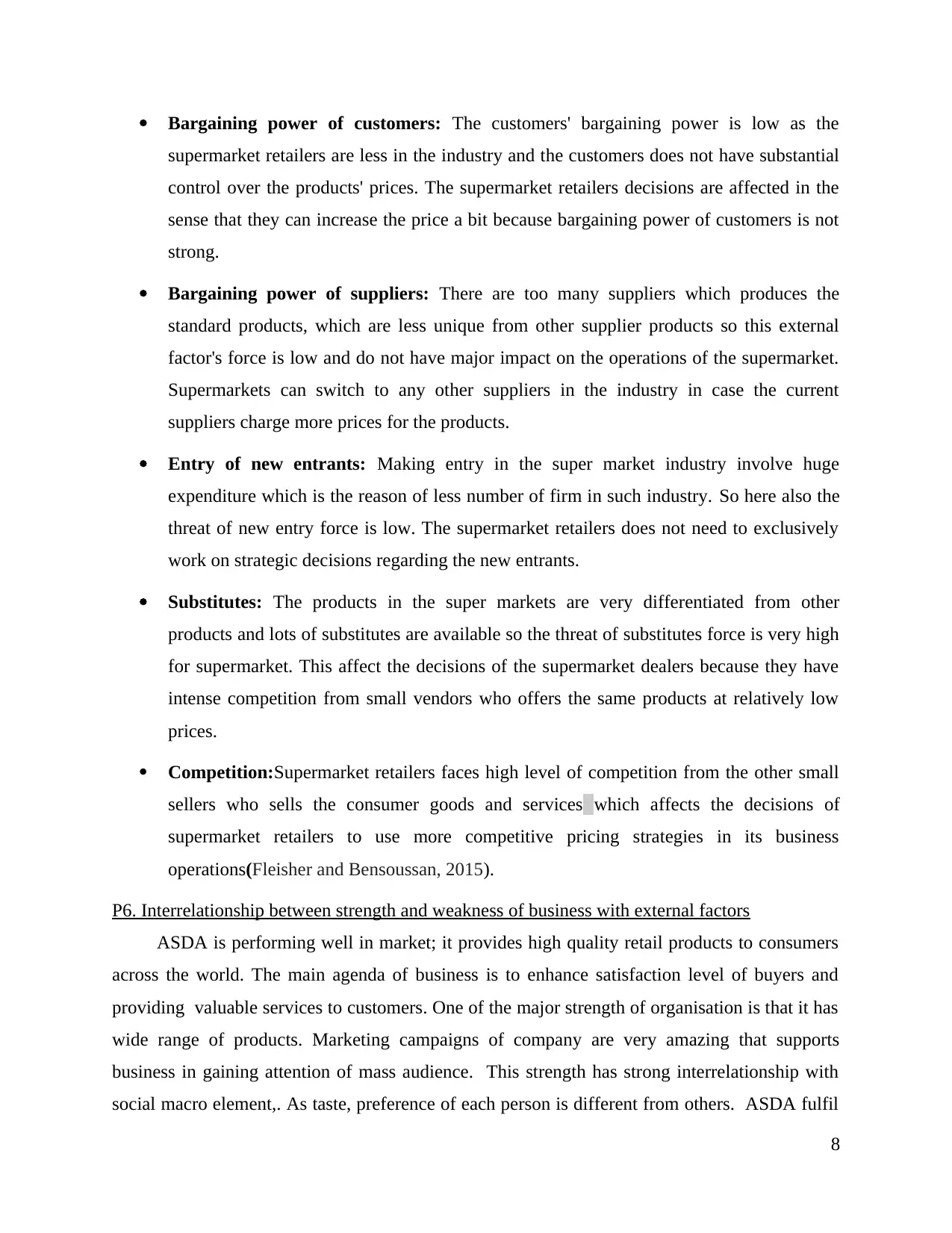
Bargaining power of customers: The customers' bargaining power is low as the
supermarket retailers are less in the industry and the customers does not have substantial
control over the products' prices. The supermarket retailers decisions are affected in the
sense that they can increase the price a bit because bargaining power of customers is not
strong.
Bargaining power of suppliers: There are too many suppliers which produces the
standard products, which are less unique from other supplier products so this external
factor's force is low and do not have major impact on the operations of the supermarket.
Supermarkets can switch to any other suppliers in the industry in case the current
suppliers charge more prices for the products.
Entry of new entrants: Making entry in the super market industry involve huge
expenditure which is the reason of less number of firm in such industry. So here also the
threat of new entry force is low. The supermarket retailers does not need to exclusively
work on strategic decisions regarding the new entrants.
Substitutes: The products in the super markets are very differentiated from other
products and lots of substitutes are available so the threat of substitutes force is very high
for supermarket. This affect the decisions of the supermarket dealers because they have
intense competition from small vendors who offers the same products at relatively low
prices.
Competition:Supermarket retailers faces high level of competition from the other small
sellers who sells the consumer goods and services which affects the decisions of
supermarket retailers to use more competitive pricing strategies in its business
operations(Fleisher and Bensoussan, 2015).
P6. Interrelationship between strength and weakness of business with external factors
ASDA is performing well in market; it provides high quality retail products to consumers
across the world. The main agenda of business is to enhance satisfaction level of buyers and
providing valuable services to customers. One of the major strength of organisation is that it has
wide range of products. Marketing campaigns of company are very amazing that supports
business in gaining attention of mass audience. This strength has strong interrelationship with
social macro element,. As taste, preference of each person is different from others. ASDA fulfil
8
supermarket retailers are less in the industry and the customers does not have substantial
control over the products' prices. The supermarket retailers decisions are affected in the
sense that they can increase the price a bit because bargaining power of customers is not
strong.
Bargaining power of suppliers: There are too many suppliers which produces the
standard products, which are less unique from other supplier products so this external
factor's force is low and do not have major impact on the operations of the supermarket.
Supermarkets can switch to any other suppliers in the industry in case the current
suppliers charge more prices for the products.
Entry of new entrants: Making entry in the super market industry involve huge
expenditure which is the reason of less number of firm in such industry. So here also the
threat of new entry force is low. The supermarket retailers does not need to exclusively
work on strategic decisions regarding the new entrants.
Substitutes: The products in the super markets are very differentiated from other
products and lots of substitutes are available so the threat of substitutes force is very high
for supermarket. This affect the decisions of the supermarket dealers because they have
intense competition from small vendors who offers the same products at relatively low
prices.
Competition:Supermarket retailers faces high level of competition from the other small
sellers who sells the consumer goods and services which affects the decisions of
supermarket retailers to use more competitive pricing strategies in its business
operations(Fleisher and Bensoussan, 2015).
P6. Interrelationship between strength and weakness of business with external factors
ASDA is performing well in market; it provides high quality retail products to consumers
across the world. The main agenda of business is to enhance satisfaction level of buyers and
providing valuable services to customers. One of the major strength of organisation is that it has
wide range of products. Marketing campaigns of company are very amazing that supports
business in gaining attention of mass audience. This strength has strong interrelationship with
social macro element,. As taste, preference of each person is different from others. ASDA fulfil
8
Secure Best Marks with AI Grader
Need help grading? Try our AI Grader for instant feedback on your assignments.
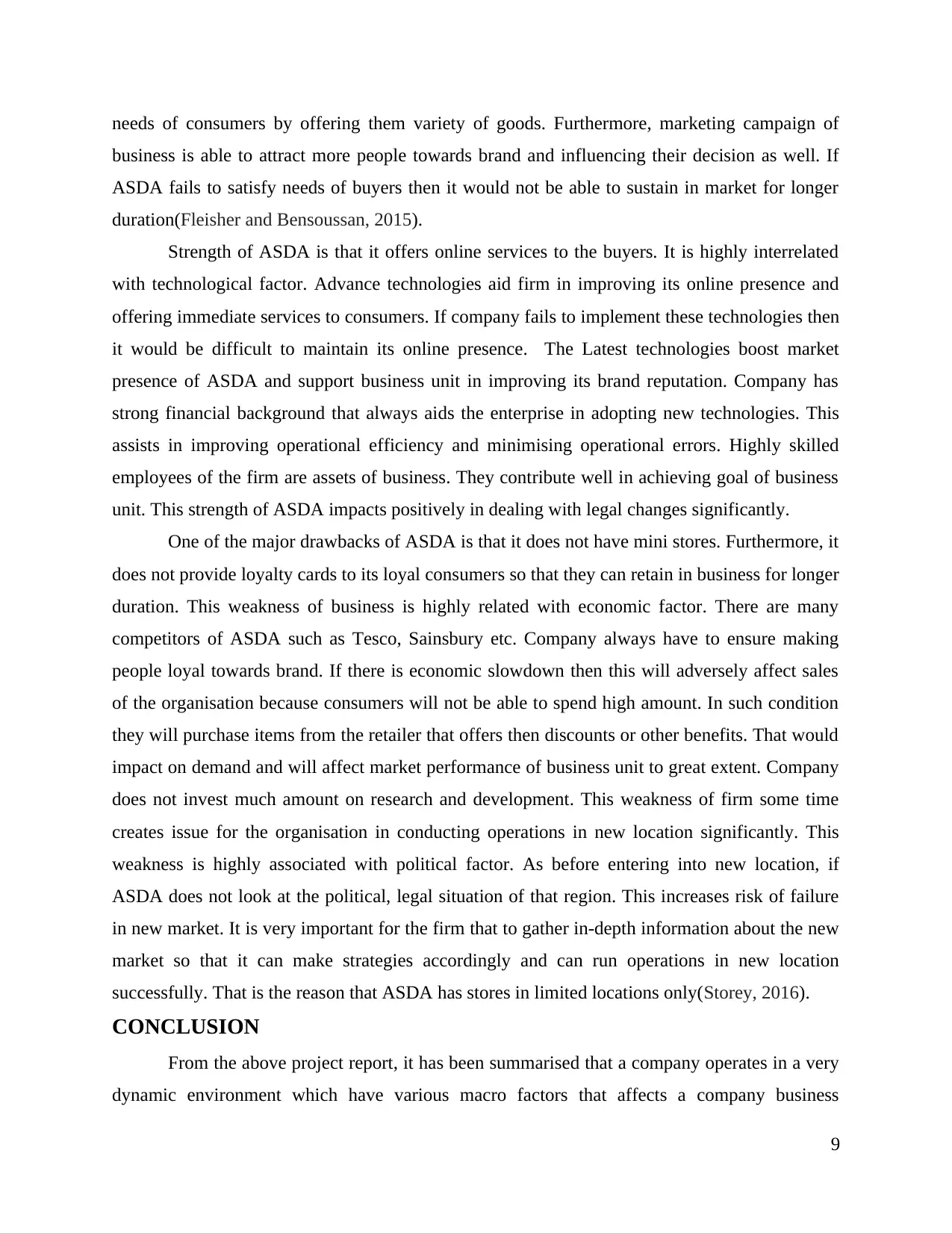
needs of consumers by offering them variety of goods. Furthermore, marketing campaign of
business is able to attract more people towards brand and influencing their decision as well. If
ASDA fails to satisfy needs of buyers then it would not be able to sustain in market for longer
duration(Fleisher and Bensoussan, 2015).
Strength of ASDA is that it offers online services to the buyers. It is highly interrelated
with technological factor. Advance technologies aid firm in improving its online presence and
offering immediate services to consumers. If company fails to implement these technologies then
it would be difficult to maintain its online presence. The Latest technologies boost market
presence of ASDA and support business unit in improving its brand reputation. Company has
strong financial background that always aids the enterprise in adopting new technologies. This
assists in improving operational efficiency and minimising operational errors. Highly skilled
employees of the firm are assets of business. They contribute well in achieving goal of business
unit. This strength of ASDA impacts positively in dealing with legal changes significantly.
One of the major drawbacks of ASDA is that it does not have mini stores. Furthermore, it
does not provide loyalty cards to its loyal consumers so that they can retain in business for longer
duration. This weakness of business is highly related with economic factor. There are many
competitors of ASDA such as Tesco, Sainsbury etc. Company always have to ensure making
people loyal towards brand. If there is economic slowdown then this will adversely affect sales
of the organisation because consumers will not be able to spend high amount. In such condition
they will purchase items from the retailer that offers then discounts or other benefits. That would
impact on demand and will affect market performance of business unit to great extent. Company
does not invest much amount on research and development. This weakness of firm some time
creates issue for the organisation in conducting operations in new location significantly. This
weakness is highly associated with political factor. As before entering into new location, if
ASDA does not look at the political, legal situation of that region. This increases risk of failure
in new market. It is very important for the firm that to gather in-depth information about the new
market so that it can make strategies accordingly and can run operations in new location
successfully. That is the reason that ASDA has stores in limited locations only(Storey, 2016).
CONCLUSION
From the above project report, it has been summarised that a company operates in a very
dynamic environment which have various macro factors that affects a company business
9
business is able to attract more people towards brand and influencing their decision as well. If
ASDA fails to satisfy needs of buyers then it would not be able to sustain in market for longer
duration(Fleisher and Bensoussan, 2015).
Strength of ASDA is that it offers online services to the buyers. It is highly interrelated
with technological factor. Advance technologies aid firm in improving its online presence and
offering immediate services to consumers. If company fails to implement these technologies then
it would be difficult to maintain its online presence. The Latest technologies boost market
presence of ASDA and support business unit in improving its brand reputation. Company has
strong financial background that always aids the enterprise in adopting new technologies. This
assists in improving operational efficiency and minimising operational errors. Highly skilled
employees of the firm are assets of business. They contribute well in achieving goal of business
unit. This strength of ASDA impacts positively in dealing with legal changes significantly.
One of the major drawbacks of ASDA is that it does not have mini stores. Furthermore, it
does not provide loyalty cards to its loyal consumers so that they can retain in business for longer
duration. This weakness of business is highly related with economic factor. There are many
competitors of ASDA such as Tesco, Sainsbury etc. Company always have to ensure making
people loyal towards brand. If there is economic slowdown then this will adversely affect sales
of the organisation because consumers will not be able to spend high amount. In such condition
they will purchase items from the retailer that offers then discounts or other benefits. That would
impact on demand and will affect market performance of business unit to great extent. Company
does not invest much amount on research and development. This weakness of firm some time
creates issue for the organisation in conducting operations in new location significantly. This
weakness is highly associated with political factor. As before entering into new location, if
ASDA does not look at the political, legal situation of that region. This increases risk of failure
in new market. It is very important for the firm that to gather in-depth information about the new
market so that it can make strategies accordingly and can run operations in new location
successfully. That is the reason that ASDA has stores in limited locations only(Storey, 2016).
CONCLUSION
From the above project report, it has been summarised that a company operates in a very
dynamic environment which have various macro factors that affects a company business
9
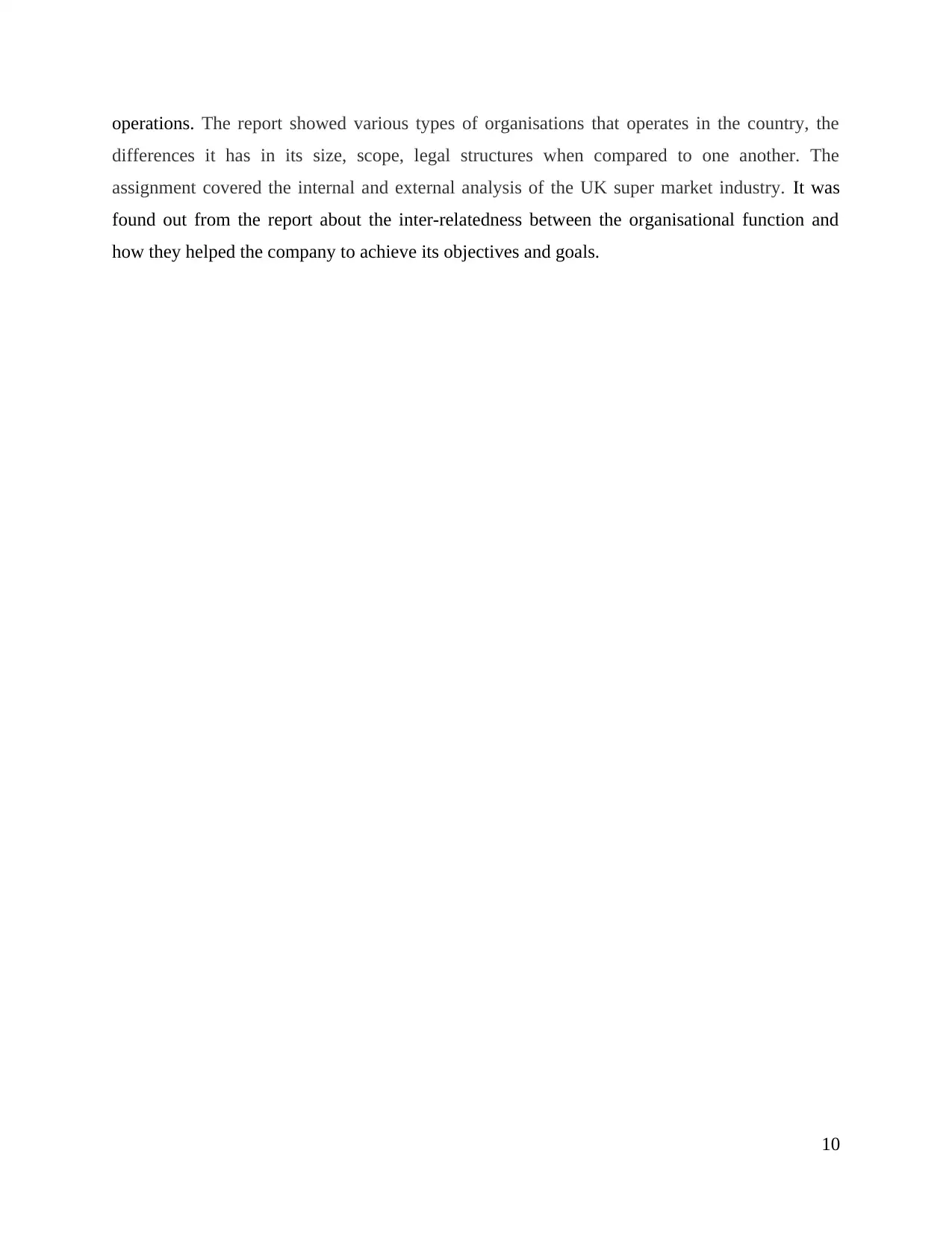
operations. The report showed various types of organisations that operates in the country, the
differences it has in its size, scope, legal structures when compared to one another. The
assignment covered the internal and external analysis of the UK super market industry. It was
found out from the report about the inter-relatedness between the organisational function and
how they helped the company to achieve its objectives and goals.
10
differences it has in its size, scope, legal structures when compared to one another. The
assignment covered the internal and external analysis of the UK super market industry. It was
found out from the report about the inter-relatedness between the organisational function and
how they helped the company to achieve its objectives and goals.
10
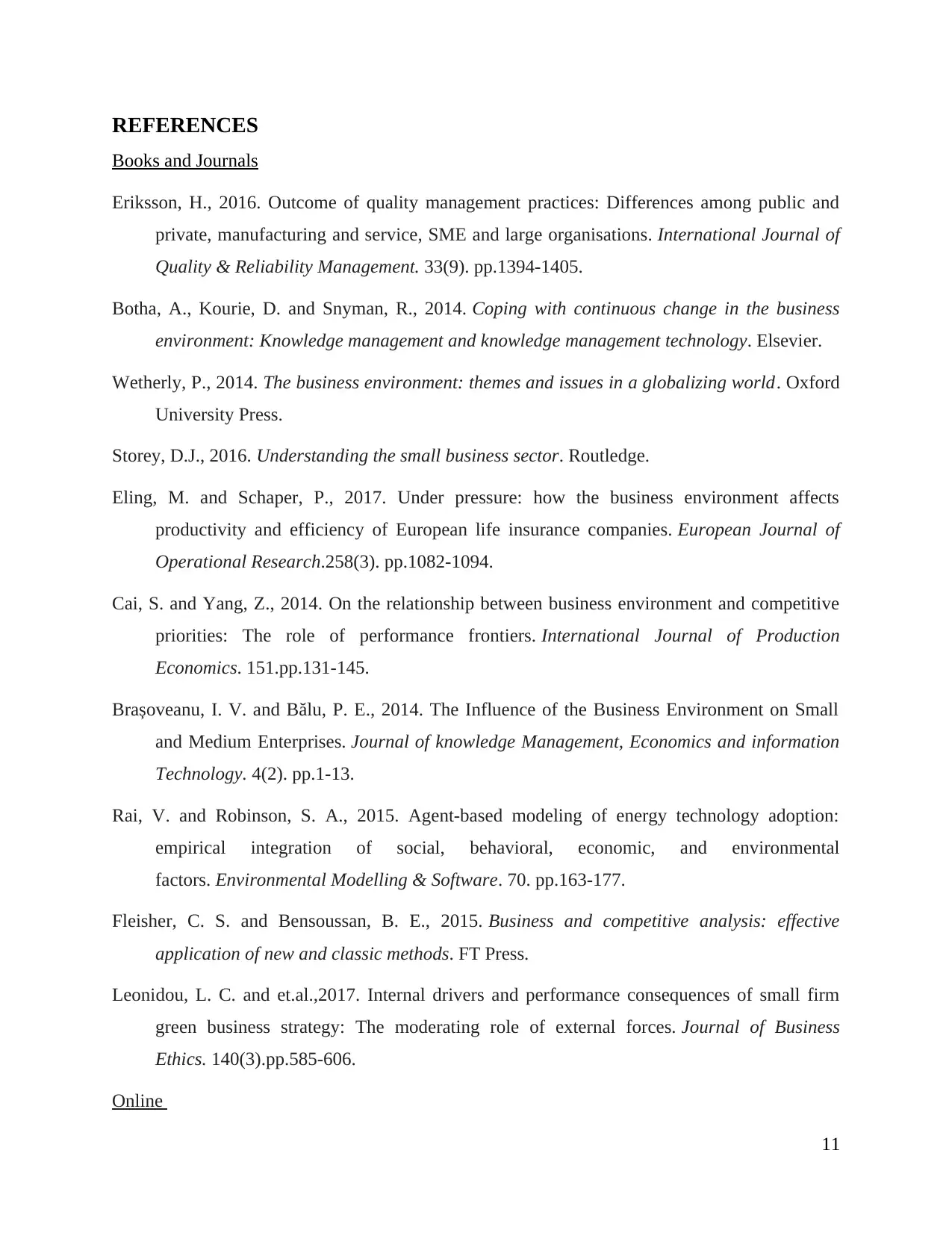
REFERENCES
Books and Journals
Eriksson, H., 2016. Outcome of quality management practices: Differences among public and
private, manufacturing and service, SME and large organisations. International Journal of
Quality & Reliability Management. 33(9). pp.1394-1405.
Botha, A., Kourie, D. and Snyman, R., 2014. Coping with continuous change in the business
environment: Knowledge management and knowledge management technology. Elsevier.
Wetherly, P., 2014. The business environment: themes and issues in a globalizing world. Oxford
University Press.
Storey, D.J., 2016. Understanding the small business sector. Routledge.
Eling, M. and Schaper, P., 2017. Under pressure: how the business environment affects
productivity and efficiency of European life insurance companies. European Journal of
Operational Research.258(3). pp.1082-1094.
Cai, S. and Yang, Z., 2014. On the relationship between business environment and competitive
priorities: The role of performance frontiers. International Journal of Production
Economics. 151.pp.131-145.
Brașoveanu, I. V. and Bălu, P. E., 2014. The Influence of the Business Environment on Small
and Medium Enterprises. Journal of knowledge Management, Economics and information
Technology. 4(2). pp.1-13.
Rai, V. and Robinson, S. A., 2015. Agent-based modeling of energy technology adoption:
empirical integration of social, behavioral, economic, and environmental
factors. Environmental Modelling & Software. 70. pp.163-177.
Fleisher, C. S. and Bensoussan, B. E., 2015. Business and competitive analysis: effective
application of new and classic methods. FT Press.
Leonidou, L. C. and et.al.,2017. Internal drivers and performance consequences of small firm
green business strategy: The moderating role of external forces. Journal of Business
Ethics. 140(3).pp.585-606.
Online
11
Books and Journals
Eriksson, H., 2016. Outcome of quality management practices: Differences among public and
private, manufacturing and service, SME and large organisations. International Journal of
Quality & Reliability Management. 33(9). pp.1394-1405.
Botha, A., Kourie, D. and Snyman, R., 2014. Coping with continuous change in the business
environment: Knowledge management and knowledge management technology. Elsevier.
Wetherly, P., 2014. The business environment: themes and issues in a globalizing world. Oxford
University Press.
Storey, D.J., 2016. Understanding the small business sector. Routledge.
Eling, M. and Schaper, P., 2017. Under pressure: how the business environment affects
productivity and efficiency of European life insurance companies. European Journal of
Operational Research.258(3). pp.1082-1094.
Cai, S. and Yang, Z., 2014. On the relationship between business environment and competitive
priorities: The role of performance frontiers. International Journal of Production
Economics. 151.pp.131-145.
Brașoveanu, I. V. and Bălu, P. E., 2014. The Influence of the Business Environment on Small
and Medium Enterprises. Journal of knowledge Management, Economics and information
Technology. 4(2). pp.1-13.
Rai, V. and Robinson, S. A., 2015. Agent-based modeling of energy technology adoption:
empirical integration of social, behavioral, economic, and environmental
factors. Environmental Modelling & Software. 70. pp.163-177.
Fleisher, C. S. and Bensoussan, B. E., 2015. Business and competitive analysis: effective
application of new and classic methods. FT Press.
Leonidou, L. C. and et.al.,2017. Internal drivers and performance consequences of small firm
green business strategy: The moderating role of external forces. Journal of Business
Ethics. 140(3).pp.585-606.
Online
11
Paraphrase This Document
Need a fresh take? Get an instant paraphrase of this document with our AI Paraphraser
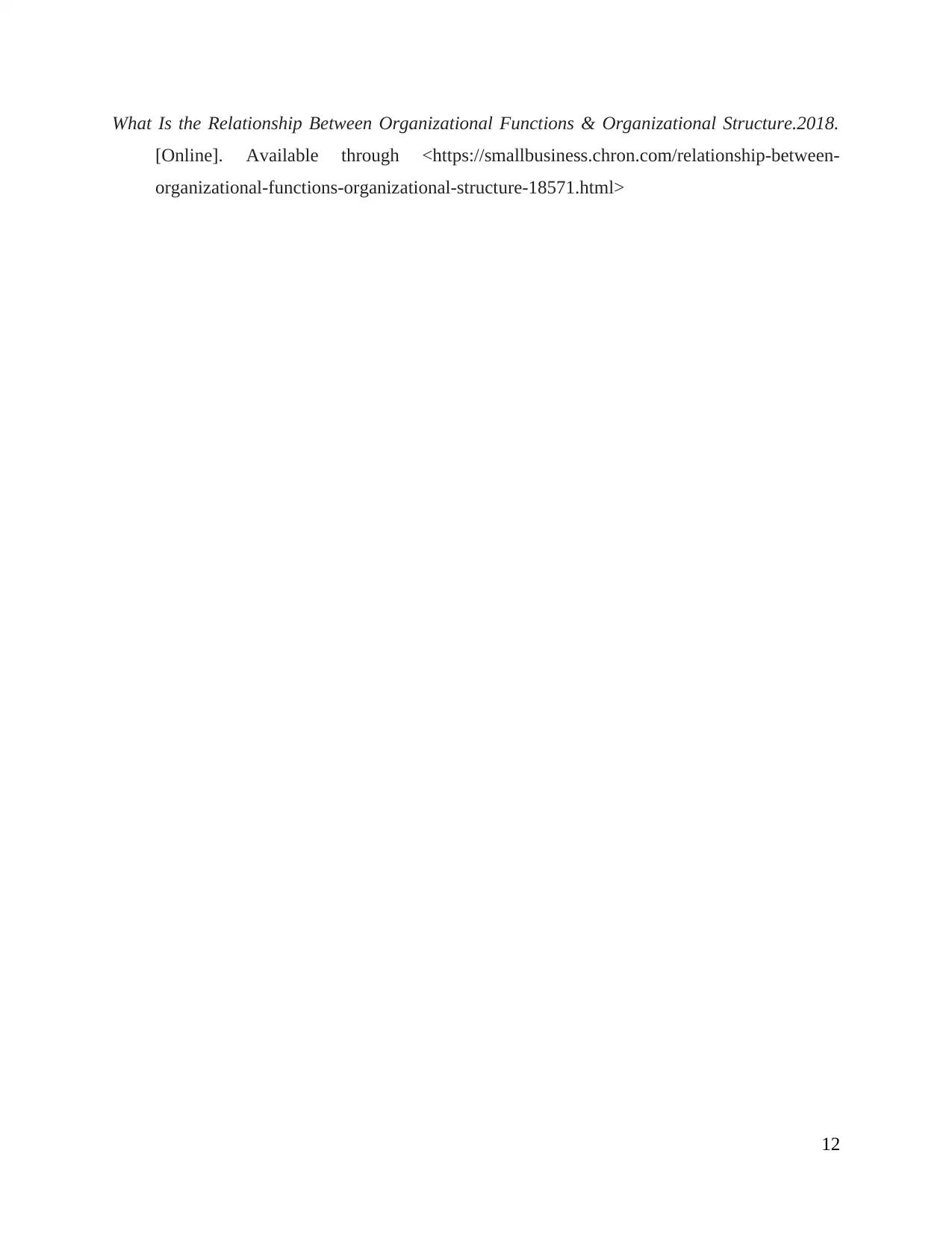
What Is the Relationship Between Organizational Functions & Organizational Structure.2018.
[Online]. Available through <https://smallbusiness.chron.com/relationship-between-
organizational-functions-organizational-structure-18571.html>
12
[Online]. Available through <https://smallbusiness.chron.com/relationship-between-
organizational-functions-organizational-structure-18571.html>
12
1 out of 14
Related Documents
Your All-in-One AI-Powered Toolkit for Academic Success.
+13062052269
info@desklib.com
Available 24*7 on WhatsApp / Email
![[object Object]](/_next/static/media/star-bottom.7253800d.svg)
Unlock your academic potential
© 2024 | Zucol Services PVT LTD | All rights reserved.





